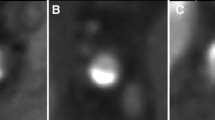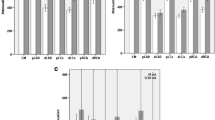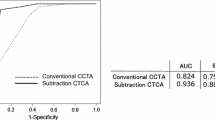Abstract
Purpose
This study was done to evaluate the diagnostic accuracy of 64-slice computed tomography coronary angiography (CTCA) for the detection of significant coronary artery stenosis in the real clinical world.
Materials and method
From the CTCA database of our institution, we enrolled 145 patients (92 men, 52 women, mean age 63.4 ± 10.2 years) with suspected coronary artery disease. All patients presented with atypical or typical chest pain and underwent CTCA and conventional coronary angiography (CA). For the CTCA scan (Sensation 64, Siemens, Germany), we administered an IV bolus of 100 ml of iodinated contrast material (Iomeprol 400 mgI/ml, Bracco, Italy). The CTCA and CA reports used to evaluate diagnostic accuracy adopted ≥50% and ≥70%, respectively, as thresholds for significant stenosis.
Result
Eleven patients were excluded from the analysis because of the nondiagnostic quality of CTCA. The prevalence of disease demonstrated at CA was 63% (84/134). Sensitivity, specificity and positive and negative predictive values for CTCA on a per-segment, per-vessel, and per-patient basis were 75.6%, 85.1%, 97.6%; 86.9%, 81.8%, 58.0%; 48.2%, 68.1%, 79.6%; and 95.7%, 92.3%, 93.5%, respectively. Only two out of 134 eligible patients were false negative. Heart rate did not significantly influence diagnostic accuracy, whereas the absence or minimal presence of coronary calcification improved diagnostic accuracy. The positive and negative likelihood ratios at the per-patient level were 2.32 and 0.041, respectively.
Conclusion
CTCA in the real clinical world shows a diagnostic performance lower than reported in previous validation studies. The excellent negative predictive value and negative likelihood ratio make CTCA a noninvasive gold standard for exclusion of significant coronary artery disease.
Riassunto
Obiettivo
Valutare l’accuratezza diagnostica dell’angiografia coronarica non invasiva con tomografia computerizzata (CT-CA) a 64 strati nell’individuazione delle stenosi coronariche significative (riduzione del lume coronarico ≥50%) basando la valutazione sulla refertazione clinica.
Materiali e metodi
Dal database della CT-CA sono stati arruolati nello studio 145 pazienti (92 maschi, 52 femmine, età media 63,4±10,2 anni) con sospetta malattia coronarica. I pazienti si presentavano con dolore toracico atipico o angina pectoris stabile e hanno poi eseguito CT-CA e coronarografia convenzionale (CAG). Per la scansione CT-CA (Sensation 64, Siemens, Germania) sono stati iniettati endovena 100 ml di mezzo di contrasto. (Iomeprol 400 mgI/ml, Bracco, Italia). I referti della CT-CA e della CAG sono utilizzati per la valutazione dell’accuratezza diagnostica utilizzano la definizione di stenosi ≥50% per la CT-CA e ≥70% per la CAG.
Risultati
Undici pazienti sono stati esclusi dall’analisi per CT-CA di qualità insufficiente. La prevalenza di malattia dimostrata alla CAG era del 63% (84/134). Sensibilità, specificità, valore predittivo positivo e negativo della CT-CA nella determinazione delle stenosi significative utilizzando un’analisi per segmento, per vaso e per paziente sono risultate del 75,6%, 85,1%, 97,6%; 86,9%, 81,8%, 58,0%; 48,2%, 68,1%, 79,6%; e 95,7%, 92,3%, 93,5%, rispettivamente. Solo due pazienti su 134 eleggibili per lo studio sono risultati falsi negativi. La frequenza cardiaca non ha mostrato influenzare significativamente l’accuratezza diagnostica, mentre la presenza di scarse o assenti calcificazioni coronariche ha determinato un incremento dei valori di accuratezza diagnostica. I likelihood ratio positivo e negativo nell’analisi per paziente sono risultati 2,32 e 0,041, rispettivamente.
Conclusioni
La CT-CA nel mondo reale mostra una performance diagnostica inferiore rispetto agli studi di validazione pubblicati in letteratura. I valori ottimali di valore predittivo negativo e likelihood ratio negativo collocano la CT-CA tra le metodiche non invasive gold standard per l’esclusione di malattia coronarica critica.
Similar content being viewed by others
References/Bibliografia
Cademartiri F, Luccichenti G, Marano R et al (2003) Non-invasive angiography of the coronary arteries with multislice computed tomography: state of the art and future prospects. Radiol Med 106:284–296
Cademartiri F, Luccichenti G, Marano R et al (2003) Spiral CT-angiography with one, four, and sixteen slice scanners. Technical note. Radiol Med 106:269–283
Mollet NR, Cademartiri F, Nieman K et al (2004) Multislice spiral computed tomography coronary angiography in patients with stable angina pectoris. J Am Coll Cardiol 43:2265–2270
Cademartiri F, Malagutti P, Belgrano M (2005) Non-invasive coronary angiography with 64-slice computed tomography. Minerva Cardioangiol 53:465–472
Cademartiri F, Runza G, Belgrano M et al (2005) Introduction to coronary imaging with 64-slice computed tomography. Radiol Med 110:16–41
Mollet NR, Cademartiri F, Krestin GP et al (2005) Improved diagnostic accuracy with 16-row multi-slice computed tomography coronary angiography. J Am Coll Cardiol 45:128–132
Mollet NR, Cademartiri F, van Mieghem CA et al (2005) High-resolution spiral computed tomography coronary angiography in patients referred for diagnostic conventional coronary angiography. Circulation 112:2318–2323
Nieman K, Oudkerk M, Rensig BJ et al (2001) Coronary angiography with multislice computed tomography. Lancet 357:599–603
Nieman K, Cademartiri F, Lemos PA et al (2002) Reliable noninvasive coronary angiography with fast submillimeter multislice spiral computed tomography. Circulation 106:2051–2054
Nieman K, Rensing BJ, van Geuns RJ et al (2002) Usefulness of multislice computed tomography for detecting obstructive coronary artery disease. Am J Cardiol 89:913–918
Ropers D, Baum U, Pohle K et al (2003) Detection of coronary artery stenoses with thin-slice multi-detector row spiral computed tomography and multiplanar reconstruction. Circulation 107:664–666
Achenbach S, Ropers D, Pohle FK et al (2005) Detection of coronary artery stenoses using multi-detector CT with 16 × 0.75 collimation and 375 ms rotation. Eur Heart J 26:1978–1986
Raff GL, Gallagher MJ, O’Neill WW, Goldstein JA (2005) Diagnostic accuracy of noninvasive coronary angiography using 64-slice spiral computed tomography. J Am Coll Cardiol 46:552–557
Leschka S, Alkadhi H, Plass A et al (2005) Accuracy of MSCT coronary angiography with 64-slice technology: first experience. Eur Heart J 26:1482–1487
Schuijf JD, Pundziute G, Jukema JW et al (2006) Diagnostic accuracy of 64-slice multislice computed tomography in the noninvasive evaluation of significant coronary artery disease. Am J Cardiol 98:145–148
Garcia MJ, Lessick J, Hoffmann MH (2006) Accuracy of 16-row multidetector computed tomography for the assessment of coronary artery stenosis. JAMA 296:403–411
Ropers D, Rixe J, Anders K et al (2006) Usefulness of multidetector row spiral computed tomography with 64-× 0.6-mm collimation and 330-ms rotation for the noninvasive detection of significant coronary artery stenoses. Am J Cardiol 97:343–348
Fox K, Garcia MA, Ardissino D et al (2006) Guidelines on the management of stable angina pectoris: executive summary: the Task Force on the Management of Stable Angina Pectoris of the European Society of Cardiology. Eur Heart J 27:1341–1381
Hendel RC, Patel MR, Kramer CM et al (2006) Appropriateness criteria for cardiac computed tomography and cardiac magnetic resonance imaging: a report of the American College of Cardiology Foundation Quality Strategic Directions Committee Appropriateness Criteria Working Group, American College of Radiology, Society of Cardiovascular Computed Tomography, Society for Cardiovascular Magnetic Resonance, American Society of Nuclear Cardiology, North American Society for Cardiac Imaging, Society for Cardiovascular Angiography and Interventions, and Society of Interventional Radiology. J Am Coll Cardiol 48:1475–1497
Nikolaou K, Rist C, Wintersperger BJ et al (2006) Clinical value of MDCT in the diagnosis of coronary artery disease in patients with a low pretest likelihood of significant disease. Am J Roentgenol 186:1659–1668
Cademartiri F, Nieman K, van der Lugt A (2004) Intravenous contrast material administration at 16-detector row helical CT coronary angiography: test bolus versus bolus-tracking technique. Radiology 233:817–823
Austen WG, Edwards JE, Frye RL (1975) A reporting system on patients evaluated for coronary artery disease. Report of the Ad Hoc Committee for Grading of Coronary Artery Disease, Council on Cardiovascular Surgery, American Heart Association. Circulation 51:5–40
Cademartiri F, Mollet NR, Lemos PA et al (2005) Impact of coronary calcium score on diagnostic accuracy for the detection of significant coronary stenosis with multislice computed tomography angiography. Am J Cardiol 95:1225–1227
Cademartiri F, Runza G, Mollet NR et al (2005) Impact of intravascular enhancement, heart rate, and calcium score on diagnostic accuracy in multislice computed tomography coronary angiography. Radiol Med 110:42–51
Jakobs TF, Becker CR, Ohnesorge B et al (2002) Multislice helical CT of the heart with retrospective ECG gating: reduction of radiation exposure by ECG-controlled tube current modulation. Eur Radiol 12:1081–1086
Flohr TG, McCollough CH, Bruder H et al (2005) First performance evaluation of a dual-source CT (DSCT) system. Eur Radiol 16:256–268
Achenbach S, Ropers D, Kuettner A et al (2006) Contrast-enhanced coronary artery visualization by dual-source computed tomography-initial experience. Eur J Radiol 57:331–335
Johnson TR, Nikolaou K, Wintersperger BJ et al (2006) Dual-source CT cardiac imaging: initial experience. Eur Radiol 16:1409–1415
Scheffel H, Alkadhi H, Plass A et al (2006) Accuracy of dual-source CT coronary angiography: first experience in a high pre-test probability population without heart rate control. Eur Radiol 16:2739–2747
Author information
Authors and Affiliations
Corresponding author
Rights and permissions
About this article
Cite this article
Cademartiri, F., Maffei, E., Notarangelo, F. et al. 64-slice computed tomography coronary angiography: diagnostic accuracy in the real world. Radiol med 113, 163–180 (2008). https://doi.org/10.1007/s11547-008-0241-1
Received:
Accepted:
Published:
Issue Date:
DOI: https://doi.org/10.1007/s11547-008-0241-1




